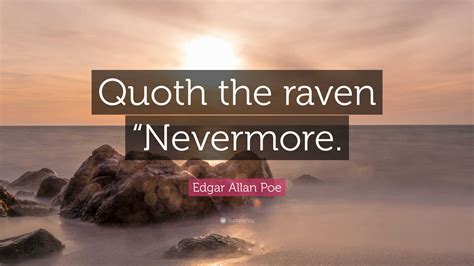Quoth The Raven

As we delve into the mystical realm of Edgar Allan Poe's masterpiece, "The Raven," we find ourselves entwined in a dance of darkness and light, where the boundaries between reality and fantasy blur. The poem, first published in 1845, has become an iconic representation of the Gothic and horror genres, continuing to captivate audiences with its haunting beauty and profound exploration of the human psyche. At its core, "The Raven" is a tale of love, loss, and the unyielding mystery of death, all woven together by the masterful hand of Poe.
The Evolution of a Masterpiece

Poe’s inspiration for “The Raven” is a subject of much speculation, with many scholars attributing it to the death of his young wife, Virginia Clemm, who succumbed to tuberculosis in 1847, two years after the poem’s publication. However, the seeds of the poem’s conception were likely sown earlier, in Poe’s fascination with the works of Charles Dickens and the emerging literary movements of his time. The character of the raven itself is believed to have been inspired by Dickens’ raven in “Barnaby Rudge,” though Poe’s interpretation is distinctly his own, imbuing the bird with an air of ominous intelligence and supernatural insight.
The Poetic Structure: A Reflection of the Psyche
The poem’s structure, with its repetitive refrain and archaic language, serves to heighten the sense of hypnotic dread that pervades the narrative. Poe’s use of trochaic octameter, with its consistent rhythm and emphasis on the first syllable of each foot, creates a sense of relentless forward motion, mirroring the narrator’s descent into madness. The introduction of the raven, with its haunting repetition of the word “nevermore,” drives home the finality of death, leaving the narrator, and by extension the reader, with a profound sense of existential despair.
| Poetic Device | Example from the Poem |
|---|---|
| Symbolism | The raven, representing death and the mysteries of the afterlife |
| Repetition | The refrain "Quoth the Raven, 'Nevermore'" |
| Metaphor | Comparing the narrator's heart to a "sepulchre" by the sea |

Key Points
- The poem "The Raven" by Edgar Allan Poe is a seminal work in the Gothic and horror genres, exploring themes of love, loss, and death.
- Poe's inspiration for the poem is attributed to various sources, including the death of his wife and literary influences of his time.
- The character of the raven is a symbol of death and the supernatural, adding to the poem's mystique and sense of foreboding.
- The poem's structure, including its use of trochaic octameter and repetitive refrain, contributes to its hypnotic and haunting effect.
- "The Raven" continues to captivate audiences with its profound exploration of the human psyche, making it a timeless classic in literature.
Interpretations and Adaptations

Over the years, “The Raven” has been subject to numerous interpretations and adaptations, each offering a unique perspective on Poe’s work. From the classic illustrations of Gustave Doré to the more recent film adaptations, the poem’s themes and characters have been reimagined in various forms of media, cementing its place in popular culture. The poem’s influence can also be seen in literature, with authors such as H.P. Lovecraft and Stephen King drawing inspiration from Poe’s mastery of the macabre.
Psychological Insights
Psychologically, “The Raven” offers a fascinating case study of grief, obsession, and the blurring of reality and fantasy. The narrator’s descent into madness, triggered by the loss of his beloved Lenore, serves as a powerful exploration of the human psyche under duress. The raven, with its unyielding presence and ominous words, represents the narrator’s own subconscious, forcing him to confront the reality of his loss and the finality of death.
The poem's exploration of the human condition, with all its complexities and vulnerabilities, is a testament to Poe's profound understanding of psychology and his ability to craft narratives that resonate deeply with readers. As we reflect on the poem's themes and characters, we are reminded of the power of literature to capture the essence of human experience, with all its joys and sorrows, and to transcend time, speaking to generations yet to come.
What is the significance of the raven in the poem?
+The raven is a symbol of death and the supernatural, serving as a messenger from the afterlife. Its repetition of the word "nevermore" drives home the finality of death, emphasizing the narrator's loss and the impossibility of reunion with his beloved Lenore.
How does the poem's structure contribute to its effect?
+The poem's use of trochaic octameter and repetitive refrain creates a sense of hypnotic dread, mirroring the narrator's descent into madness. The consistent rhythm and emphasis on the first syllable of each foot contribute to the poem's haunting and mesmerizing effect.
What themes does "The Raven" explore?
+"The Raven" explores themes of love, loss, death, and the human psyche. The poem delves into the complexities of grief, obsession, and the blurring of reality and fantasy, offering a profound and timeless exploration of the human experience.
As we conclude our journey through the haunting world of “The Raven,” we are left with a profound sense of awe and reverence for Poe’s mastery of the macabre. The poem’s enduring popularity is a testament to its timeless themes and the universal human experiences it so eloquently captures. Whether we approach it as a work of Gothic horror, a psychological exploration, or a simple yet powerful tale of love and loss, “The Raven” remains an unforgettable and deeply moving experience, one that will continue to captivate and haunt readers for generations to come.



